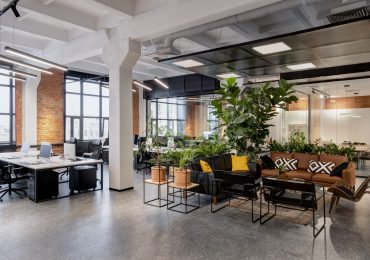
You’re in a competitive environment, and the way you create your office space can make or break your business. Here are 5 ways to build an efficient workspace so that you—and everyone else who comes through those doors—can be more productive.
-
Ergonomic Workstations
A crucial aspect of designing a productive office space is creating ergonomic workstations. When finding the best office space, it’s essential to prioritize comfort, adaptability, and functionality in the work environment. Ergonomic workstations not only boost productivity but also contribute to the overall well-being of employees.
The essential components of an ergonomic workstation include adjustable chairs, desks, and monitor stands. These elements allow employees to customize their workspace to suit their individual needs. It reduces the risk of developing musculoskeletal disorders or experiencing discomfort during long work hours.
Another vital aspect of an ergonomic workstation is the arrangement of office equipment and tools. Consider monitor positioning, keyboard placement, and access to frequently used items to minimize strain and promote natural body postures.
-
Dynamic Lighting Solutions
By striking a balance between natural and artificial light sources, these solutions create an optimal and adaptable brightness level that contributes to team member comfort and efficiency.
Consider the following aspects when incorporating dynamic lighting solutions into your office space:
- Natural Light Optimization: Maximize using natural light by positioning workstations near windows and utilizing open floor plans. Natural light has been proven to boost employees’ mood, alertness, and productivity.
- Layered Lighting Approach: Combine ambient, task, and accent lighting to create a well-lit, functional workspace. Ambient lighting provides general illumination, task lighting focuses on specific work areas, and accent lighting highlights architectural features or artwork.
- Adjustable Lighting Controls: Equip your office with dimmers and motion sensors, allowing employees to adjust the brightness according to their needs and preferences. It also contributes to energy efficiency and cost savings.
Integrating dynamic lighting solutions into your office space will create a more comfortable and conducive work environment, ultimately leading to higher team member satisfaction and increased productivity.
-
Inviting Breakout Spaces
Designing inviting breakout spaces in a productive office environment is vital in promoting employees’ well-being and fostering community. These spaces provide a dedicated area for relaxation, rejuvenation, and socialization away from the hustle and bustle of the main workspace.

Breakout spaces should offer a variety of amenities and activities to cater to diverse team member preferences. Providing options such as board games, books, or table tennis allows employees to interact with their colleagues in a more informal setting and helps them unwind from work-related stressors.
Furthermore, designing breakout spaces with separate areas or partitions allows for privacy, ensuring that employees who prefer solitude to recharge can also benefit from these dedicated spaces. You can also design breakout spaces with multiple levels, which allows employees to move between areas depending on their mood or level of concentration.
-
Collaborative Office Zones
Creating collaborative office zones is a crucial design element in a productive office space, as they encourage teamwork, creativity, and effective communication among employees. These dedicated areas accommodate group interactions, brainstorming sessions, and informal meetings.
- Open And Flexible Layouts: Design open-concept spaces that can be easily reconfigured to adapt to various team sizes and activities. Mobile furniture and movable partitions can provide versatility and encourage spontaneous collaboration.
- Various Seating Options: Offer a mix of seating arrangements, such as couches, lounge chairs, and standing tables, to cater to different work styles and preferences. It allows employees to choose the most comfortable and collaborative setting.
- Acoustic Considerations: Design with acoustics in mind to minimize noise distractions and maintain appropriate privacy. Use sound-absorbing materials like acoustic panels or partitions to create a comfortable and focused collaborative environment.
- Visual Aids: Provide ample writable surfaces, such as whiteboards or glass walls, to encourage idea generation, brainstorming, and visual thinking during collaborative sessions.
By designing collaborative office zones that cater to the needs and preferences of your employees, you will create a workspace that fosters teamwork, creativity, and increased productivity, ultimately contributing to your company’s overall success.
-
Biophilic Office Design
Biophilic design, centered around integrating nature and natural elements into built environments, has reduced stress, enhanced cognitive function, and fostered creativity. By leveraging the power of nature, you can create a healthier and more inspiring work environment.
One of the key aspects of biophilic office design is the inclusion of plants and greenery. Adding indoor plants, living walls or even green roofs not only enhances the visual appeal of the workspace but also contributes to improved air quality, noise reduction, and a sense of calm. Incorporating natural materials, textures, and patterns into the office design can also evoke a sense of connection to nature.
Takeaway
The design of a productive office space plays a significant role in shaping team member performance, satisfaction, and overall well-being. By incorporating these five key design elements, you can transform your workspace into a dynamic and engaging hub that fosters collaboration, innovation, and efficiency.